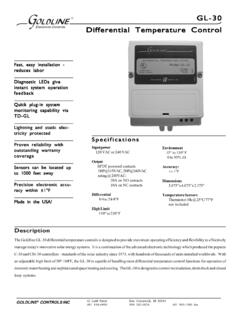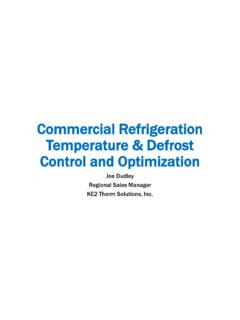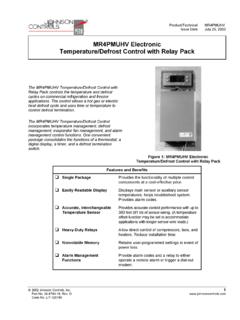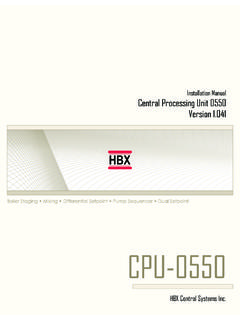Transcription of Economizer High Limit Controls and Why Enthalpy ...
1 November 2010 ASHRAE Journal 1 Outdoor air economizers use controllable dampers to increase the amount of outside air drawn into the building when the outside air is cool or cold and the system requires cooling. They are required by energy standards such as Standard in most commercial cooling applications. A typical design is shown in Figure 1. Supply air temperature is maintained at setpoint by first opening the Economizer outdoor air damper and closing the return air damper, then opening the chilled water valve if additional cooling is required. A key element of the Economizer control system is the high Limit switch that determines whether outdoor air is, in fact, appropriate for cooling and enables or disables the Economizer dampers accordingly. This high Limit device, which has long been misunderstood, is the subject of this purpose of the high Limit switch is to disable the Economizer when its use would increase the energy used by the cooling coil, , when cooling re-turn air will use less mechanical cooling energy than cooling outdoor air.
2 Deter-mining when the changeover condition occurs is complicated by the fact that cooling coils both cool and dehumidify supply air. Figure 2 is a psychrometric chart showing entering coil conditions that have a higher dew-point tempera-ture than the desired supply air tempera-ture so the air is dehumidified (wet coil). Coil cooling energy is proportional to the Enthalpy difference across the coil from the entering condition to the sup-ply air condition. The return air condi-tion in this example is 76 F (24 C) dry-bulb temperature with a humidity ratio of 68 grains/lbda ( gw/gda) (1 grain = 7,000 lbw). If the outdoor air were 78 F and 60 grains/lbda (26 C and gw/gda) (outdoor air condition #2, green dot, Figure 2), the Enthalpy difference across the coil would be less than that required to cool return air to the supply air temperature despite the fact that the About the AuthorsSteven T.
3 Taylor, , is a principal and C. Hwa-kong Cheng is a designer at Taylor Engineering LLC, a consulting engineering firm in Alameda, Calif. Economizer High Limit Controls andWhy Enthalpy economizers Don t WorkBy Steven T. Taylor, , Fellow ASHRAE; and C. Hwakong Cheng, Member ASHRAEThis article was published in ASHRAE Journal, November 2010. Copyright 2010 American Society of Heating, Refrigerating and Air-Conditioning Engineers, Inc. Reprinted here by permission from ASHRAE at This article may not be copied nor distributed in either paper or digital form by other parties without ASHRAE s permission. For more information about ASHRAE, visit ASHRAE Journal November 2010dry-bulb temperature is higher than the return air dry-bulb temperature. This is because the outdoor air results in a lower latent cooling load.
4 Conversely, if the outdoor air were 74 F and 92 grains/lbda (23 C and gw/gda) (outdoor air condition #1, red dot, Figure 2), it would take more energy to cool than the return air despite having a lower dry-bulb tem-perature, due to the higher latent load component. So, with a wet coil (if the return air has a higher dew-point tem-perature than the supply air temperature Outdoor AirMinimum OA DamperEconomizer OA DamperRA DamperReturn AirHigh Limit SwitchSupply FanCHW ValveSupply Air Temperature ControllerSupply Air Temperature SensorFigure 1: Outdoor air Economizer Temperature ( F)Humidity Ratio, grains/lb of Dry AirFigure 3: Optimum high Limit logic: dry , assuming near saturated conditions leaving the coil as is typical of a wet coil), the optimum Economizer high Limit logic is to cool the airstream that has the lower Enthalpy .
5 The physics of a dry coil is quite different. In Figure 3, entering coil dew-point temperatures are below the supply air temperature dew point, so no dehumidification occurs. The energy use across the coil is still proportional to the Enthalpy difference, but the leaving air is no longer near saturation; the humidity ratio is the same as the entering airstream. With a dry coil, cooling outdoor air from 81 F and 46 grains/lbda (27 C and gw/gda) takes more energy than cooling the return air, despite a lower Enthalpy . Therefore, optimum dry coil logic is to cool the airstream that has the lowest dry-bulb temperature, regardless of humidity. These two figures are combined in Figure 4. Interestingly, only seldom is this combined wet/dry ( Enthalpy /dry-bulb) logic recognized as being For instance, ASHRAE s new green building Standard has requirements for en-thalpy and dry-bulb high Limit devices, but no requirement for combined Enthalpy and dry-bulb high Limit logic.
6 In these figures and in the discussion later, it is assumed that the Economizer is fully integrated, meaning the Economizer and mechanical cooling can operate simultaneously. This is al-ways true of chilled water systems and those direct expansion (DX) systems with modulating or several stages of capacity control , but it is generally not the case for small DX units with limited unloading capability. The optimum Economizer con-trol for non-integrated or partially integrated DX equipment will vary by application and, in humid climates, must consider the impact on space humidity that results from compressor cy-cling. The results and recommendations discussed below may not apply to these non-integrated economizers . For fully inte-grated economizers , the selection of high Limit control will not cause any increase in humidity in humid weather.
7 This can be seen in Figure 2; the supply air condition is the same regard-less of entering air condition, and it is the supply air condition that determines the room humidity. High Limit control StrategiesThe most common high Limit Controls are: Fixed dry-bulb temperature; Differential (or dual) dry-bulb temperature; Fixed Enthalpy ; Dry-Bulb Temperature ( F)Humidity Ratio, grains/lb of Dry AirFigure 2: Optimum high Limit logic: wet coil. Differential (or dual) Enthalpy ; and Combinations of the of these Controls has inherent errors conditions where they make the wrong choice between the outdoor air and return airstreams causing an increase in energy use November 2010 ASHRAE Journal 3compared to the ideal logic (Figure 4). These errors increase in practice due to sensor calibration error.
8 These issues are discussed in more detail for each high Limit control below. Fixed Dry-Bulb Temperature With a fixed dry-bulb high Limit , outside air temperature is measured and compared to a fixed setpoint, enabling the Economizer if the outdoor air temperature is below the set-point. This was the first, and remains the simplest and least expensive high Limit control , requiring only a single tem-perature sensor or thermostat mounted in the outdoor 5 is a psychrometric chart showing fixed dry-bulb control with setpoint equal to 72 F (22 C) superimposed over ideal control . The areas shaded in red represent outside air con-ditions where the control strategy makes an error by incorrectly selecting the more energy intensive airstream. In this example, the return air is 76 F and 68 grains/lbda (24 C and gw/gda); this condition varies throughout the year.
9 In the upper red tri-angle, the control incorrectly supplies humid outdoor air. In the lower red rectangle, the control incorrectly disables the econo-mizer when outdoor air would have reduced coil load. Figure 6 is the same chart with a setpoint of 65 F (18 C). This setpoint reduces the number of hours the control incor-rectly supplies humid air (upper triangle), but it increases the number of hours when the Economizer incorrectly is disabled in dry weather. In humid climates, those with many hours in the upper triangle and fewer hours in the lower rectangle, this lower setpoint will improve efficiency. This will be seen in the energy simulations discussed below. Dry-Bulb Temperature ( F)Humidity Ratio, grains/lb of Dry AirFigure 4: Optimum high Limit logic: wet or dry Temperature ( F)Humidity Ratio, grains/lb of Dry AirFigure 5: Fixed dry-bulb high Limit error: setpoint 72 Temperature ( F)Humidity Ratio, grains/lb of Dry AirFigure 6: Fixed dry-bulb high Limit error: setpoint 65 Temperature ( F)Humidity Ratio, grains/lb of Dry AirFigure 7: Differential dry-bulb high Limit ASHRAE Journal November 2010 Differential Dry-Bulb Temperature With a differential dry-bulb high Limit , both outside air and return air temperatures are measured and the Economizer is disabled when the outside air temperature exceeds the return air temperature.
10 This control logic will always make the right choice (barring sensor error) between airstreams when the coil is dry (Figure 7, see Page 3), but also always makes an error when outdoor air is cool but humid (upper triangle). The im-pact of this error depends on the climate. It will have almost no effect in San Francisco (Figure 8) since there are very few hours with the outdoor air conditions in this error triangle. But the error will be significant in Atlanta (Figure 9) where there are many hours in this error triangle. In these figures, the annual number of hours between 6 and 6 at each psychrometric condition is indicated by a colored square indi-cating the frequency as indicated in the scale on the left. Fixed EnthalpyFixed Enthalpy high Limit Controls measure outside air Enthalpy and compare it to a fixed setpoint, typically equal to the expected Enthalpy of the return air ( , 28 Btu/lbda [65 kJ/kg]), disabling the Economizer if the outdoor air enthal-py is above the setpoint.





